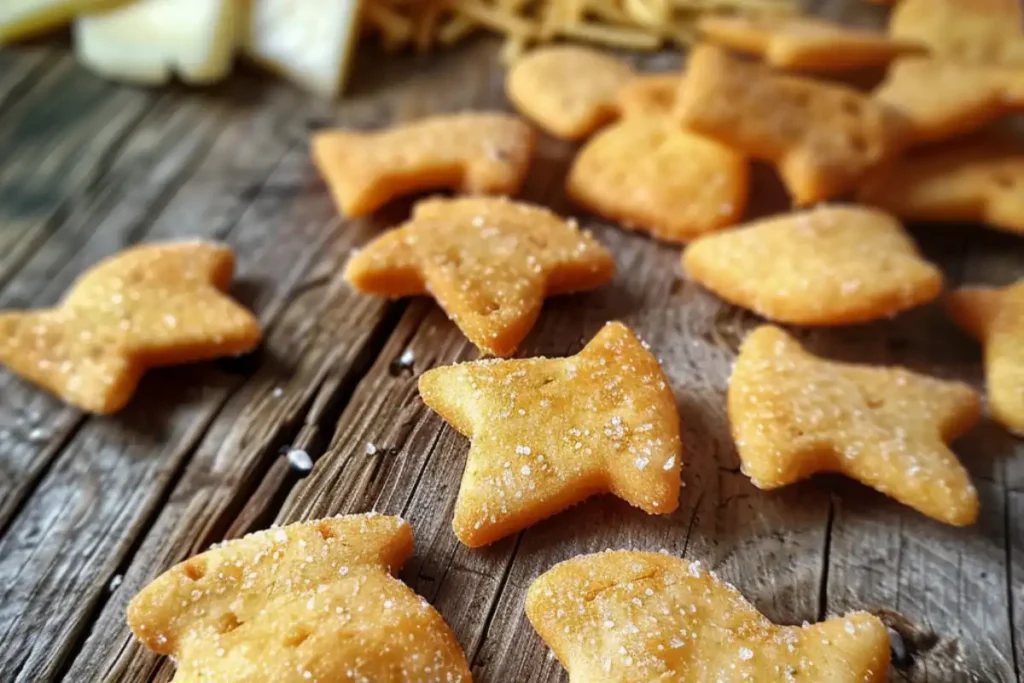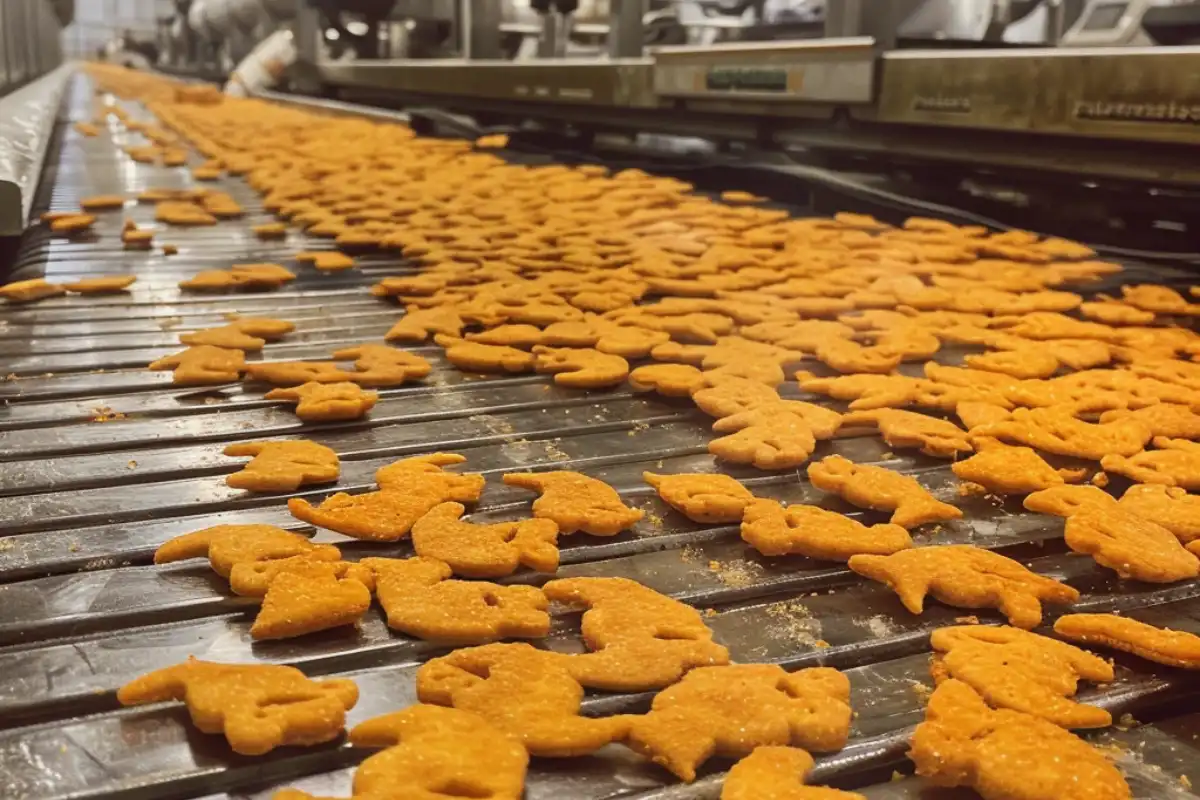Goldfish crackers have been a beloved snack in households across the world, especially in the United States. Their unique fish shape, crispy texture, and cheesy flavor make them irresistible to both children and adults. But have you ever wondered how these tiny crackers are made? In this article, we’ll take a deep dive into the fascinating process of making Goldfish crackers, from the history of their creation to the detailed production methods used today.
If you’re interested in the broader context of how snacks are made, you might find this guide on snack food manufacturing insightful, as it covers various techniques used in the industry.
The History of Goldfish Crackers
Origin Story
The story of Goldfish crackers begins in the 1950s when a Swiss biscuit-maker named Oscar J. Kambly created the snack for his wife, who he described as being his “little goldfish.” The original idea was to craft a small, fish-shaped cracker that would bring joy to his wife, and it didn’t take long for the concept to catch on. The crackers were a hit in Switzerland, where they were first produced by the Kambly Company.
In the 1960s, Pepperidge Farm, a company known for its premium baked goods, discovered Goldfish crackers and decided to introduce them to the American market. The founder of Pepperidge Farm, Margaret Rudkin, was so impressed by the crackers that she negotiated the rights to produce and sell them in the United States. This marked the beginning of the iconic snack’s journey into American households.
For more on the history of Pepperidge Farm and its influence on American snacks, check out the official history of Pepperidge Farm, which details the company’s rise to prominence.
Evolution Over the Years
Since their introduction to the U.S. market, Goldfish crackers have evolved significantly. Initially, they were only available in their classic cheddar flavor. However, as their popularity grew, so did the variety of flavors and shapes. Today, Goldfish crackers come in a range of flavors, including Parmesan, pretzel, pizza, and even sweet varieties like s’mores.
Goldfish have also become a cultural icon, often featured in marketing campaigns aimed at both children and adults. The snack’s success can be attributed to its unique combination of taste, nostalgia, and branding, making it a staple in American snack culture.

For those interested in creating their own snack favorites at home, you might find our easy homemade Goldfish cheddar crackers recipe an exciting project.
Ingredients Used in Goldfish Crackers
To understand how Goldfish crackers are made, you need to begin with the ingredients. The quality and selection of these ingredients play a crucial role in creating the distinct flavor and texture that make Goldfish crackers so recognizable.
Key Ingredients
- Flour: The production process primarily uses enriched wheat flour as the base for Goldfish crackers. This type of flour creates a light, crispy texture that holds up well during baking.
- Cheese: Real cheddar cheese, one of the most important ingredients, gives Goldfish their iconic flavor. The team typically ages the cheese to enhance its sharpness before mixing it into the dough, ensuring even distribution throughout each cracker.
- Oils and Fats: To achieve the desired texture and extend shelf life, the recipe includes a combination of oils and fats. The team commonly uses canola oil and sunflower oil because they provide a neutral flavor and contribute to the desirable crispiness when baked.
- Seasonings: The team adds salt and other seasonings like garlic powder, onion powder, and paprika to enhance the flavor of the crackers. They carefully measure these seasonings to maintain consistency across batches.
For those curious about trying out new flavor combinations, our article on strawberry crunch poke cake explores how different ingredients can be combined to create unique flavors in baking.
Additives and Preservatives
For a more detailed look at the nutritional content and additives in cheese crackers, including Goldfish, you can explore this nutritional guide for cheese crackers.
The Production Process of Goldfish Crackers
The process of making Goldfish crackers is highly specialized, combining traditional baking techniques with modern technology. Here’s a step-by-step breakdown of how production teams create these crackers in large-scale facilities.
Dough Preparation
The production process begins with preparing the dough. Large industrial mixers combine ingredients like flour, cheese, oils, and seasonings.
- Mixing: This crucial step ensures even distribution of the cheese and seasonings throughout the dough. The dough needs the right consistency—firm enough to hold its shape, yet pliable enough for shaping and baking.
- Kneading: After mixing, the team kneads the dough to develop gluten, which provides structure to the crackers. This step is vital for achieving the ideal texture in the final product.
Shaping the Crackers
Once the dough is ready, the team shapes the crackers. They achieve the iconic fish shape of Goldfish crackers using specially designed molds and cutters.
- Molding: The team rolls out the dough into thin sheets and passes them through a stamping machine that quickly and efficiently cuts out thousands of fish shapes per minute.
- Eyes and Smile: One of the most charming features of Goldfish crackers is their smiling face. A small stamp presses the eyes and mouth onto each cracker before baking, giving them their characteristic look.
Baking the Crackers
Baking is a critical step in the production of Goldfish crackers, as it determines their texture and flavor.
- Temperature: The team bakes the crackers at high temperatures, typically around 400°F (200°C). This high heat crisps the outside of the crackers while keeping the inside slightly soft.
- Baking Time: They carefully time the baking process to prevent the crackers from burning. The crackers bake for just a few minutes, which is enough to achieve their characteristic crunch.
Seasoning and Packaging
After baking, the production team seasons the crackers according to the desired flavor profile.
- Seasoning: The team may add additional seasonings depending on the flavor variety. For instance, they might dust extra cheese powder on top of the cheddar Goldfish to enhance the flavor.
- Packaging: Once seasoned, the crackers cool before moving to the packaging lines. Here, the system weighs and seals them in airtight bags to maintain freshness. This packaging process ensures that the crackers remain in perfect condition when they reach consumers.

Popular Flavors and Varieties of Goldfish Crackers
Goldfish crackers come in a wide variety of flavors, catering to different tastes and preferences. Here’s a look at some of the most popular options.
Classic Flavors
- Cheddar: The original and most popular flavor, made with real cheddar cheese. It’s the flavor that started it all and remains a favorite among fans.
- Parmesan: A slightly milder flavor with a nutty undertone, Parmesan Goldfish are perfect for those who prefer a less intense cheese flavor.
- Pretzel: Combining the salty crunch of a pretzel with the classic Goldfish shape, this variety offers a savory alternative to the cheese-based flavors.
Limited Edition and Specialty Flavors
Pepperidge Farm regularly releases limited edition and specialty flavors to keep the Goldfish lineup fresh and exciting.
- Pizza: Featuring a blend of cheese, tomato, and herbs, Pizza Goldfish are a hit with those who enjoy a bit of Italian flavor in their snacks.
- S’mores: A sweet variety that combines graham cracker Goldfish with chocolate and marshmallow flavors. This flavor is often released as a limited edition.
- Holiday Editions: During the holidays, you might find seasonal flavors like pumpkin spice or peppermint, adding a festive twist to the classic snack.
For those who enjoy seasonal flavors, you might find our article on how to make a delicious pork chop casserole equally appealing, offering a cozy dish perfect for colder months.
Goldfish Varieties
Beyond flavors, Goldfish crackers are also available in different varieties to cater to various dietary preferences.
- Whole Grain: Made with whole grain flour, these crackers offer a healthier option without compromising on flavor.
- Organic: For those who prefer organic snacks, Pepperidge Farm offers an organic version of Goldfish crackers, made with organic ingredients.
- Goldfish Grahams: A sweet twist on the classic, Goldfish Grahams are available in flavors like honey and cinnamon.
Nutritional Information of Goldfish Crackers
While Goldfish crackers are undeniably tasty, it’s important to consider their nutritional content, especially if they’re a regular part of your diet.
Caloric Content
A typical serving of Goldfish crackers (about 55 pieces) contains approximately 140 calories. The calorie count can vary slightly depending on the flavor and variety.
Macronutrients
- Fat: Most varieties contain around 5-6 grams of fat per serving. This includes both unsaturated fats from the oils used and a small amount of saturated fat from the cheese.
- Protein: Goldfish crackers provide about 3 grams of protein per serving, primarily from the cheese and flour.
- Carbohydrates: With around 20 grams of carbohydrates per serving, Goldfish are a source of quick energy.
Dietary Considerations
- Vegetarians: Most Goldfish varieties are suitable for vegetarians, as they do not contain meat or gelatin.
- Gluten-Free: Traditional Goldfish crackers are not gluten-free, but there are gluten-free alternatives available for those with gluten sensitivities.
- Allergens: Goldfish crackers contain wheat and dairy, making them unsuitable for those with allergies to these ingredients.
FAQs About How Goldfish Crackers Are Made
Are Goldfish Crackers Made with Real Cheese?
- Yes, real cheese is used to make Goldfish crackers, which is one of the key ingredients that gives them their distinct flavor. Typically, the production team ages the cheese to enhance its sharpness before mixing it into the dough. Using real cheese sets Goldfish crackers apart from other snacks that rely on artificial cheese flavors.
How Do They Get the Fish Shape?
- In the production process, molds and cutters shape the Goldfish crackers into their iconic fish form. The team rolls out the dough into thin sheets and passes them through a stamping machine that cuts out the fish shapes. A small stamp then adds the eyes and smile, giving each cracker its characteristic look.
Are There Artificial Ingredients in Goldfish?
- While Goldfish crackers contain some natural ingredients, such as real cheese and natural coloring agents, they also include certain additives and preservatives. However, the trend in recent years has been towards using more natural ingredients, particularly in response to consumer demand for cleaner labels.
Can I Make Goldfish Crackers at Home?
- Yes, you can make your own Goldfish crackers at home using simple ingredients like flour, cheese, and butter. Homemade Goldfish allow you to control the ingredients and customize the flavors to your liking.
For those who enjoy DIY snacks, check out our homemade Goldfish recipe, which offers a healthier, customizable alternative to the store-bought version.
Conclusion
Goldfish crackers have been a staple in snack aisles for decades, beloved for their unique shape, delicious taste, and nostalgic appeal. From their humble beginnings in Switzerland to becoming a household name in America, Goldfish have captured the hearts and taste buds of many.
Whether you enjoy the classic cheddar flavor, prefer the spicy kick of newer varieties, or want to try making them yourself, you’ll find that Goldfish crackers offer a versatile and delightful treat that continues to stand the test of time.
If you’re looking for more culinary inspiration, our article on what to eat with mac and cheese provides excellent pairing ideas for another classic comfort food.

